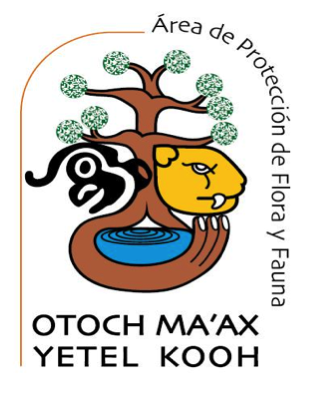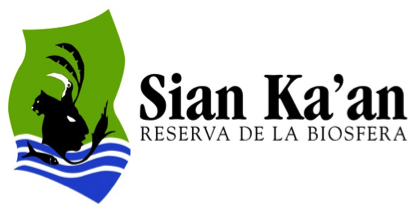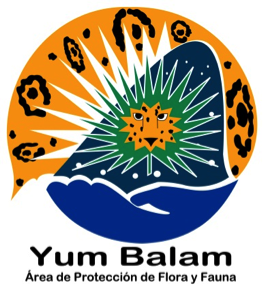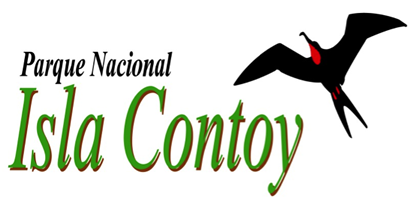Site Visits May 30th
Otoch Ma'ax Yetel Kooh

The Otoch Ma'ax Yetel Kooh Reserve (House of the spider monkey and the puma in Yucatec Maya) is a community-based conservation effort in Punta Laguna that started in 1979 to preserve the forest and the existing Mayan archaeological remains of the area. Over time, research and conservation organizations and local NGOs became involved in empowering the community with knowledge of the local fauna, principally primates and birds. This process culminated with the recognition by the Mexican Government of the Otoch Ma'ax Yetel Kooh Reserve as a Protected Area of Wild Flora and Fauna in June of 2002
The Reserve comprises 5,367 hectares covered by different vegetation types such as tropical semi-evergreen forest, flooded swamp forest and flooded grasslands or savannas; and contains one of the more important surface water systems of the Yucatan Peninsula. In addition, the reserve is home to 215 local and migratory bird species and a troop of approximately 300 spider monkeys.
Other relevant species include the collared peccary, the Central American brocket deer or yuk, and endangered species such as the puma, jaguar, margay, and the howler monkey.
There are also many plant varieties including 19 endemic species and two that are on the endangered species list and a wide range of orchids and bromeliads.
Sian Ka’an

The Biosphere Reserve of Sian Ka’an (“Where the sky is born” in Yucatec Maya) on the Caribbean coast of the Yucatan Peninsula was established in 1986, forming part of UNESCO’s Man and the Biosphere program. In 1987 the reserve was declared a UNESCO World Heritage Site, and since 1993 it is a RAMSAR site. Sian Ka’an is one of the 5 largest Protected Areas in Mexico with approximately 650,000 hectares under conservation. The reserve covers a wide variety of ecosystems including diverse wetlands (mangroves, swamps), forests (tropical semi-evergreen forest, flooded swamp forests), lagoons, coastal zones and a marine protected area with important coral reef systems and seagrass beds. There are also 23 archeological sites within the reserve.
Sian Ka’an has registered more than 100 species of mammals including the five tropical cats: jaguar, puma, ocelot, margay and jaguarondi. Other mammals include Central American tapir, Caribbean manatee, spider monkey, howler monkey, white-tailed deer, red brocket deer (Mazama americana – yuc in Yucatec Maya), white-lipped peccary, and collared anteater.
There are more than 339 bird species, with many marine and wading birds such as the frigate, cormorant, roseate spoonbill, flamingo and the jabiru; 16 raptor species and 42 species of amphibians and reptiles. Four of the six turtle species registered in Mexico are also found: green, hawksbill, loggerhead and leatherback.
The GEF has supported diverse activities through different both full-sized projects and the Small Grants Program. The Protected Areas Fund project has been fundamental in the consolidation of the management and sustainability of the Reserve. Two of the five Mexican recipients of the Equator
Yum Balam

The Protected Area of Wild Flora and Fauna Yum Balam (Lord of the Forest in Yucatec Maya) is located in the northern part of the Mayan Region of Quintana Roo. Yum Balam was declared by the federal government as a reserve on June 6th, 1994 in recognition of the efforts of the local Mayan communities supported by civil society organizations, academia and governmental agencies to conserve its natural and cultural heritage. The reserve comprises 154,052 hectares that include a variety of ecosystems such as tropical semi-evergreen forest, flooded swamp forests, mangrove swamps, lagoons, wetlands, near-shore coastal environments and a marine conservation zone.
There are at least 414 species of flora in Yum Balam, of which 96.5% are native to the region and represent 18% of existing flora in the Yucatan Peninsula. Yum Balam is also home to the five tropical cats: ocelot, jaguar, margay, jaguarundi and puma, as well as other species such as the white-lipped peccary, the West Indian manatee, Baird’s Tapir and Morelet's Crocodile. In all there are 580 species of marine fish and 23 species of freshwater fish, 340 bird species, 22 mammals, 14 types of amphibians, 67 reptile species, 168 species of insects, 186 arthropods and 18 butterfly species.
In coordination with the National Commission for Protected Areas, GEF funding has been provided through the Small Grants Program to support diverse civil society and community base organizations in both the landscapes and seascapes of the reserve in projects ranging from conservation and sustainable use of marine species (manatees and whale shark habitats), coastal zoning and land-use planning for community-based tourism, coral reef monitoring, charismatic species monitoring (jaguar) and sustainable forestry use (certified production of orchids, butterflies, beekeeping etc.).
Isla Contoy

TThe Isla Contoy National Park is located in the Isla Mujeres municipality in Quintana Roo, in the western-most part of the Yucatan Channel where the Gulf of Mexico and Caribbean Sea meet. It is 30 km north of Isla Mujeres and 32 km from Cabo Catoche. It is the oldest protected area in Quintana Roo having been originally declared in 1961 as a Natural Reserve and Fauna Refuge. It formed part of the first group of protected areas supported by the restructured Protected Areas Project partially financed by the GEF and was re-categorized in 1998 as a National Park. Isla Contoy is also a Ramsar site.
Isla Contoy is one of the few Caribbean islands in Mexico that has practically virgin terrestrial ecosystems. The flora and fauna communities constitute a natural laboratory to study processes of colonization and establishment of the populations present there. The island is the most important nesting zone for the Brown pelican on the Atlantic coast of Mexico, as well as for the double-crested cormorant and the frigatebird. It is also an important safe haven for the loggerhead, leatherback, green and hawksbill sea turtles.
IIsla Contoy was included in the restructured Protected Areas Project as one of the 10 priority reserves for GEF support. Together with Amigos de Contoy, the Nature Conservancy and other civil society partners the National Protected Areas Commission used GEF resources to consolidate the management of the reserve with infrastructure, a multi-sectorial Management Program, updated lists of flora and fauna and monitoring programs for key biological communities.






















Follow us